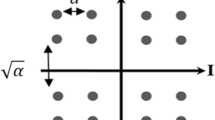Abstract
An Automatic Repeat Request (ARQ) scheme is proposed for a wireless ATM LAN based on the MEDIAN concept. Simulations have been performed to demonstrate the consequences of ARQ inclusion in terms of required buffer capacity and resulting cell end-to-end delay. In particular, the behaviour of the ARQ-enhanced system for real-time traffic under non error-free conditions has been examined. The main result of the simulations is that, due to specific properties of the MEDIAN wireless ATM LAN, the proposed ARQ scheme is suitable for real-time ATM services, while yielding virtually error-free links. Next to low cell delay, it features low overhead and low processing complexity whereas it can be readily combined with a simple and efficient MAC scheme.
Similar content being viewed by others
References
European Community ACTS MEDIAN project AC006, “Wireless Broadband CPN/LAN for Professional and Residential Multimedia Applications, Final System Design,” December 1996.
F. Delli Priscoli, “MAC and Interworking Layers for ATM Wireless System,” Wireless Personal Communications, vol. 9,no. 2, Feb. 1999, pp. 113-147.
P. Smulders, “Exploiting the 60 GHz Band for Local Wireless Multimedia Access: Prospects and Future Directions,” IEEE Communications Magazine, vol. 40,no. 1, pp. 140-147.
D.v.d. Meulenhof and P.F.M. Smulders, “Handover in a High-Speed Wireless ATM based LAN,” in IEEE Vehicular Technology Conference, Amsterdam, 19–22 Sept. 1999, pp. 1730-1734.
W.A.H. Berkvens and P.F.M. Smulders, “ARQ for Real-time Services in Wireless ATM Networks,” in Proceeding of the ACTS Mobile Communications Summit '98, Rhodes, Greece, June 1998.
W.A.H. Berkvens, “Performance of a Selective Repeat ARQ Scheme for Real-time Services in the MEDIAN System,” in ACTS Mobile Communications Summit '98, Sorrento, Italy, June 1999.
Author information
Authors and Affiliations
Rights and permissions
About this article
Cite this article
Smulders, P., de Gier, M. Modelling ARQ for a High-Speed ATM-Based Wireless LAN. The Journal of VLSI Signal Processing-Systems for Signal, Image, and Video Technology 32, 275–286 (2002). https://doi.org/10.1023/A:1020225104730
Published:
Issue Date:
DOI: https://doi.org/10.1023/A:1020225104730




